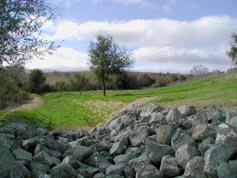
Handy Links
SLAC News Center
SLAC Today
- Subscribe
- Archives: Feb 2006-May 20, 2011
- Archives: May 23, 2011 and later
- Submit Feedback or Story Ideas
- About SLAC Today
SLAC News
Lab News
- Interactions
- Lightsources.org
- ILC NewsLine
- Int'l Science Grid This Week
- Fermilab Today
- Berkeley Lab News
- @brookhaven TODAY
- DOE Pulse
- CERN Courier
- DESY inForm
- US / LHC
SLAC Links
- Emergency
- Safety
- Policy Repository
- Site Entry Form

- Site Maps
- M & O Review
- Computing Status & Calendar
- SLAC Colloquium
- SLACspeak
- SLACspace
- SLAC Logo
- Café Menu
- Flea Market
- Web E-mail
- Marguerite Shuttle
- Discount Commuter Passes
-
Award Reporting Form
- SPIRES
- SciDoc
- Activity Groups
- Library
Stanford
Around the Bay
Environmental Restoration Succeeding at SLAC
 Under the oaks and winter green grass at SLAC, the earth is mostly bedrock. The groundwater moves slowly through this solid foundation. Thanks to the Environmental Restoration Group at SLAC, the groundwater is flowing cleaner, too.
Under the oaks and winter green grass at SLAC, the earth is mostly bedrock. The groundwater moves slowly through this solid foundation. Thanks to the Environmental Restoration Group at SLAC, the groundwater is flowing cleaner, too.
Part of the ES&H division, the group conducts cleanup activities to restore and manage areas that have been impacted by historic releases of chemicals. The work is funded by the DOE’s Office of Environmental Management.
In one case, the groundwater beneath the paint shop area of Building 35 contains about 40 types of chemicals which leaked from a former tank that held spent paint solvents. At the time, placement in an underground tank was the accepted storage method. Now, waste is put directly into above-ground containers and shipped to an appropriate waste disposal facility.
"The groundwater table is high under Building 35. The solvents make up a 250-foot long plume in the groundwater, much of which is too rich in natural minerals to be used for drinking water" said restoration group leader Micki DeCamara, a civil engineer. Her team consists of five engineers and geologists.
Even though the groundwater moves slowly, the plume began to migrate more rapidly in the late 1990s, so the group installed a remediation and containment system. Five wells, installed in 2001, pump the contaminated groundwater to the surface where carbon filters remove the chemicals. The clean water is discharged into the sanitary sewer system under permit. The pump and treat system has removed 310 pounds of chemicals to date, and the plume is now shrinking.
This year, the group plans to install a dual-phase extraction system that is expected to double the rate of chemical removal. By adding a vacuum to the top of the wells, the pumps can pull up more groundwater and extract chemical vapors that may reside in the pore space of the underlying soils and bedrock.
The group maintains more than 100 monitoring wells on site to sample groundwater in locations that have historical pollution or potential for problems and works closely on restoration efforts with regulatory agencies, including the San Francisco Bay Regional Water Quality Control Board.
In another recent project, the group restored a 330-foot long drainage channel that carries storm water from the Research Yard. The channel was cleaned up a decade ago in response to finding high levels of polychlorinated biphenyls (PCBs) in the channel sediments and soil. PCBs have historically been used in transformers and other electrical equipment at SLAC. Despite past and more recent cleanup efforts in the Research Yard, the PCBs eventually returned in the drainage channel, although at much lower levels than a decade ago. Last fall, the group excavated 500 tons of impacted sediment and soil from the drainage channel for off-site disposal. The channel was then backfilled with clean quarry soil to its original flow lines and hydro-seeded with native vegetation. Installation of erosion-control matting in the channel completed the restoration effort.
"It's nice to know that our restoration efforts contribute to providing a safe environment for our workers, ecological community, and neighboring areas," said DeCamara.
—Heather Rock Woods, January 22, 2007
Above image: The recently restored primary Interaction Region 6 drainage channel, shown here, carries storm water that eventually flows to San Francisco Bay.